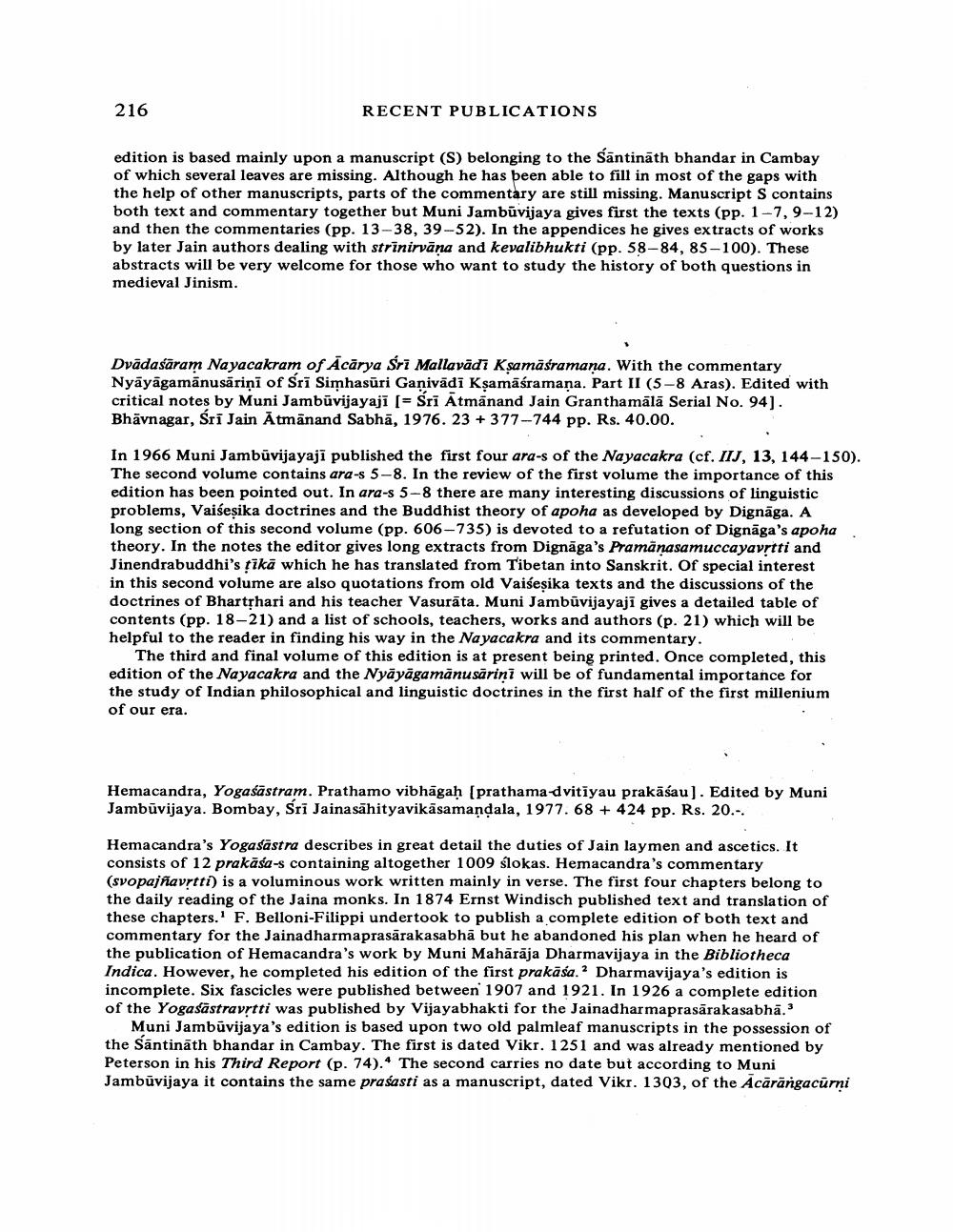Book Title: Recent Publications Author(s): Publisher: View full book textPage 4
________________ 216 RECENT PUBLICATIONS edition is based mainly upon a manuscript (S) belonging to the santinath bhandar in Cambay of which several leaves are missing. Although he has been able to fill in most of the gaps with the help of other manuscripts, parts of the commentary are still missing. Manuscript S contains both text and commentary together but Muni Jambuvijaya gives first the texts (pp. 1-7, 9-12) and then the commentaries (pp. 13-38, 39-52). In the appendices he gives extracts of works by later Jain authors dealing with strinirvana and kevalibhukti (pp. 58-84, 85-100). These abstracts will be very welcome for those who want to study the history of both questions in medieval Jinism. Dvadasaram Nayacakram of Acarya Sri Mallavadi Ksamasramana. With the commentary Nyayagamanusarini of Sri Simhasuri Ganivadi Ksamasramana. Part II (5-8 Aras). Edited with critical notes by Muni Jambuvijayaji (= Sri Atmanand Jain Granthamala Serial No. 94]. Bhavnagar, Sri Jain atmanand Sabha, 1976. 23 + 377-744 pp. Rs. 40.00. In 1966 Muni Jambuvijayaji published the first four ara-s of the Nayacakra (cf. IIJ, 13, 144-150). The second volume contains ara-s 5-8. In the review of the first volume the importance of this edition has been pointed out. In ara-s 5-8 there are many interesting discussions of linguistic problems, Vaisesika doctrines and the Buddhist theory of apoha as developed by Dignaga. A long section of this second volume (pp. 606-735) is devoted to a refutation of Dignaga's apoha theory. In the notes the editor gives long extracts from Dignaga's Pramanasamuccayavrtti and Jinendrabuddhi's tika which he has translated from Tibetan into Sanskrit. Of special interest in this second volume are also quotations from old Vaisesika texts and the discussions of the doctrines of Bhartphari and his teacher Vasurata. Muni Jambuvijayaji gives a detailed table of contents (pp. 18-21) and a list of schools, teachers, works and authors (p. 21) which will be helpful to the reader in finding his way in the Nayacakra and its commentary. The third and final volume of this edition is at present being printed. Once completed, this edition of the Nayacakra and the Nyayagamanusarini will be of fundamental importance for the study of Indian philosophical and linguistic doctrines in the first half of the first millenium of our era. Hemacandra, Yogasastram. Prathamo vibhagah (prathama dvitiyau prakasau). Edited by Muni Jambuvijaya. Bombay, Sri Jaina sahityavikasamandala, 1977. 68 + 424 pp. Rs. 20.-. Hemacandra's Yogasastra describes in great detail the duties of Jain laymen and ascetics. It consists of 12 prakasa-s containing altogether 1009 slokas. Hemacandra's commentary (svopajnavrtti) is a voluminous work written mainly in verse. The first four chapters belong to the daily reading of the Jaina monks. In 1874 Ernst Windisch published text and translation of these chapters.' F. Belloni-Filippi undertook to publish a complete edition of both text and commentary for the Jainadharmaprasarakasabha but he abandoned his plan when he heard of the publication of Hemacandra's work by Muni Maharaja Dharmavijaya in the Bibliotheca Indica. However, he completed his edition of the first prakasa.? Dharmavijaya's edition is incomplete. Six fascicles were published between 1907 and 1921. In 1926 a complete edition of the Yogasastravrtti was published by Vijayabhakti for the Jainadharmaprasarakasabha.3 Muni Jambuvijaya's edition is based upon two old palmleaf manuscripts in the possession of the Santinath bhandar in Cambay. The first is dated Vikr. 1251 and was already mentioned by Peterson in his Third Report (p. 74).4 The second carries no date but according to Muni Jambuvijaya it contains the same prasasti as a manuscript, dated Vikr. 1303, of the AcarangacumniPage Navigation
1 2 3 4 5 6
